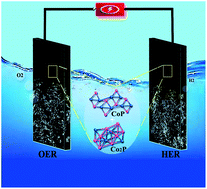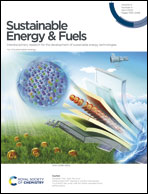Scalable and energy-efficient synthesis of CoxP for overall water splitting in alkaline media by high energy ball milling†
Abstract
Earth-abundant catalysts based on transition metal phosphides (TMPs) such as CoxP have recently gained a lot of attention in the field of electrocatalysis and are usually acquired by chemical synthesis. Herein, we present a mechanical synthesis method (high energy ball milling) for preparing a bifunctional CoxP electrocatalyst at room temperature (25 °C) using black phosphorus (BP) and cobalt(III) oxide (Co2O3) as raw materials. This safe, energy-efficient and scalable method yields a durable catalyst material, which achieves a current density of 10 mA cm−2 at low overpotentials of 69 mV and 266 mV in 1 M KOH for the HER and OER, respectively, as well as low Tafel-slopes of 50.6 mV dec−1 and 62.1 mV dec−1. When the CoxP electrocatalyst was employed for overall water splitting, current densities of 10 mA cm−2 and 100 mA cm−2 were achieved at 1.59 V and 1.97 V surpassing those of the state-of-the-art Pt/C‖RuO2 setup. Moreover, the outlined synthesis route could potentially be applied to other transition metals allowing for the facile production of other catalysts.



 Please wait while we load your content...
Please wait while we load your content...